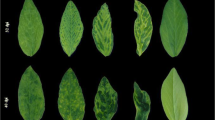Abstract
A Tropaeolum majus (nasturtium) plant with severe leaf mosaic symptoms was collected from a public park in New Zealand in September 2004. Electron microscopy of crude sap preparations revealed the presence of flexuous filamentous virus particles of different sizes. Necrotic local lesions followed by systemic leaf necrosis, chlorosis, mosaic or distortion developed on nine species of herbaceous indicator plants. The original sample and indicator plants tested positive for Broad bean wilt virus 1 (BBWV-1, genus Fabavirus) and Verbena latent virus (VeLV, genus Carlavirus) by enzymelinked immunosorbent assay (ELISA). BBWV-1 was confirmed by reverse transcription—polymerase chain reaction (RT-PCR) using generic fabavirus primers and specific BBWV-1 primers. A RT-PCR using specific primers to VeLV was developed. The BBWV-1 and VeLV amplicons each showed 96% nucleotide identity to published sequences of BBWV-1isolate PV-132 (New York,USA) and VeLV from Israel, respectively. The sample was also coinfected with Turnip mosaic virus (genus Potyvirus) and Opium poppy mosaic virus (unassigned member of the genus Umbravirus). This is the first report of BBWV-1 in New Zealand and the first report of VeLV infecting T. majus worldwide. T. majus is a common weed in New Zealand and may represent a significant reservoir for these viruses.
Similar content being viewed by others
References
Cohen J, Zeidan M, Feigelson L, Maslenin L, Rosner A, Gera A (2003) Characterization of a distinct Carlavirus isolated from Verbena: brief report. Archives of Virology 148, 1007–1015. doi:10.1007/s00705-002-0973-5
Cottier W (1953) Aphids of New Zealand. New Zealand Department of Scientific and Industrial Research Bulletin 106, 281.
Elliott DR, Lebas BSM, Ochoa-Corona FM, Tang J, Alexander BJR (2009) Investigation of Impatiens necrotic spot virus outbreaks in New Zealand. Australasian Plant Pathology 38, 490–495. doi:10.1071/AP09031
Ferrer RM, Luis-Arteaga M, Guerri J, Moreno P, Rubio L (2007) Detection and identification of species of the genus Fabavirus by RT-PCR with a single pair of primers. Journal of Virological Methods 144, 156–160. doi:10.1016/j.jviromet.2007.03.010
ICTVdB Management (2006) 00.018.0.02.001. Broad bean wilt virus 1. In ‘ICTVdB — the universal virus database. Version 4’. (Columbia University: New York) Available at http://www.ncbi.nlm.nih.gov/ ICTVdb/ICTVdB/00.018.0.02.001.htm [Last accessed 20 November 2009]
Lebas BSM, Clover GRG, Ochoa-Corona FM, Elliott DR, Tang JZ, Alexander BJR (2005a) Distribution of itPotato spindle tuber viroid in New Zealand glasshouse crops of capsicum and tomato. Australasian Plant Pathology 34, 129–133. doi:10.1071/AP05002
Lebas BSM, Ochoa-Corona FM, Elliott DR, Tang Z, Alexander BJR (2005b) Partial characterization of two unidentified Carla-like viruses from Dioscorea opposita (Dioscoreacea) and Gynura sp. (Asteraceae). New Zealand Plant Protection 58, 318.
Milne RG (1993) Electron microscopy of in vitro preparations. In ‘Diagnosis of plant virus diseases’. (Ed. REF Matthews) pp. 215–251. (CRC Press: Boca Raton, FL)
Ochoa Corona FM, Lebas BSM, Elliott DR, Tang JZ, Alexander BRJ (2007a) New host records and new host family range for Turnip mosaic virus in New Zealand. Australasian Plant Disease Notes 2, 127–130. doi:10.1071/DN07051
Ochoa Corona FM, Tang JZ, Lebas BSM, Alexander BRJ (2007b) Validation of primer design for plant virus diagnostics using the web-interface pathway Primer3-mFOLD-BLASTn. Phytopathology 97, S86.
Smith KM (1950) Some new virus diseases of ornamental plants. Journal of the Royal Horticultural Society 75, 350–353.
Tang JZ, Ochoa-Corona FM, Lebas BSM, Elliott DR, Thangavel R, Alexander BJR (2006) Detection of four viruses in Tropaelum majus in New Zealand. New Zealand Plant Protection 59, 375.
Taylor RH, Stubbs LL (1972) Broad bean wilt virus. Description of plant virus. Association of Applied Biologists (AAB) No. 81. Available at http://www.dpvweb.net/dpv/showadpv.php?dpvno=081 [Last accessed 20 November 2009]
Thornberry HH (1966) ‘Plant pests of importance to North American agriculture. Index of plant virus diseases. Agriculture handbook No. 307.’ (Washington DC, US: US Department of Agriculture, Agriculture Research Service) 211 pp.
UK CAB International (2004) ‘Distribution maps of plant diseases. Edition 1: Broad bean wilt virus. Map 925.’ (CAB International: Wallingford, UK) http://www.cabi.org/dmpd/default.aspx?LoadModule=Review&Review ID=16309&site=165&page=1353 [Last accessed 20 November 2009]
Webb CJ, Sykes CR, Garnock-Jones PJ (1988) ‘Flora of New Zealand. Vol. IV. Naturalized Pteridophytes, Gymnosperms, Dicotyledons.’ (DSIR Botany Division: Christchurch) p. XVIII.
Author information
Authors and Affiliations
Corresponding author
Rights and permissions
About this article
Cite this article
Ochoa-Corona, F.M., Tang, J., Lebas, B.S.M. et al. Diagnosis of Broad bean wilt virus 1 and Verbena latent virus in Tropaeolum majus in New Zealand. Australasian Plant Pathol. 39, 120–124 (2010). https://doi.org/10.1071/AP09070
Received:
Accepted:
Issue Date:
DOI: https://doi.org/10.1071/AP09070




